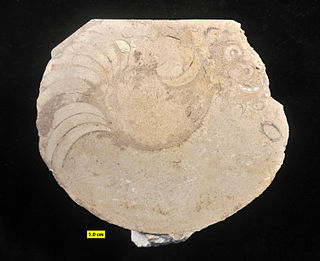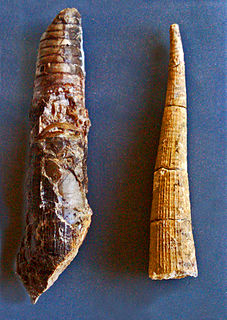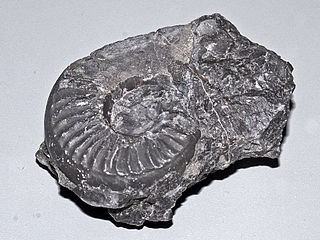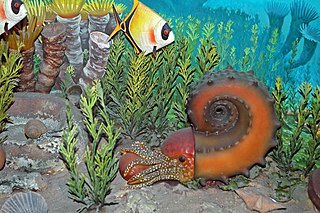 W
WNautiloids are a large and diverse group of marine cephalopods (Mollusca) belonging to the subclass Nautiloidea that began in the Late Cambrian and are represented today by the living Nautilus and Allonautilus. Nautiloids flourished during the early Paleozoic era, where they constituted the main predatory animals, and developed an extraordinary diversity of shell shapes and forms. Some 2,500 species of fossil nautiloids are known, but only a handful of species survive to the present day.
 W
WNautiloids are a large and diverse group of marine cephalopods (Mollusca) belonging to the subclass Nautiloidea that began in the Late Cambrian and are represented today by the living Nautilus and Allonautilus. Nautiloids flourished during the early Paleozoic era, where they constituted the main predatory animals, and developed an extraordinary diversity of shell shapes and forms. Some 2,500 species of fossil nautiloids are known, but only a handful of species survive to the present day.
 W
WDeltocymatoceras is an involute cymatoceratid (Nautilioidea-Nautilida) with broadly arched whorl sides, strongly convergent on a narrow venter that bears a slight, rounded, keel-like ridge, and with no distinct ventro-latera shoulders. Sides bear cymatoceratid ribs that bifurcate near the middle of the whorl sides, but do not cross the venter. The suture has a somewhat pointed ventral saddle, broad lateral lobes and prominent saddles on the umbilical shoulders. The position of the siphuncle in undetermined.
 W
WDiscoceras is an extinct marine cephalopod mollusk, a member of the Trocholitidae in the Tarphycerida. It is distinct from Discosorus, It is characterized by closely coiled, gradually expanding shells with a subquadrate cross section, that may be ribbed or smooth. The sides are broadly rounded; the venter is wide and slightly rounded. The maximum width is slightly dorsal of the middle. The dorsum has a slight to moderate impression. The siphuncle starts off central for the first half whorl then becomes marginodorsal in the succeeding two whorls, then subdorsal at maturity. As with Trocholites, the dorsal siphuncle in Discoceras probably indicates an orientation during life that places the back of the living chamber high in the shell.
 W
WDomatoceras is a nautiloid genus and member of the Grypoceratidae from the Pennsylvanian and Permian with a wide spread distribution.
 W
WEndocerida is an extinct nautiloid order, a group of cephalopods from the Lower Paleozoic with cone-like deposits in its siphuncle.
 W
WThe Estonioceratidae are a family of loosely coiled tarphycerids in which the inner side of the whorls, which forms the dorsum, is rounded or flat with no impression, and in which the siphuncle, composed of thick tubular segments, is located ventrally. The Estonioceratidae seem to form a link between the ancestral Bassleroceratidae and the more tightly coiled Tarphyceratidae.
 W
WGeisonoceras is an extinct orthocerid genus named by Hyatt, 1884, and type for the Geisonoceratidae established by Zhuravleva in 1959.
 W
WGermanonautilus is a cephalopod genus included in the nautilid family Tainoceratidae, found widespread in the Triassic of North America, Europe, Asia, and north Africa. The shell is a moderately involute nautilicone ; whorl section subquadrate to trapezoidal, widest across the umbilical shoulders, flanks flattened and ventrally convergent, venter flat and wide, dorsum narrowly and deeply impressed. The suture is with broad and deep lateral lobes and a shallow ventral lobe. The siphuncle is central and nummuloidal, composed of expanded segments that give a beaded appearance. Its color is usually brown-grey.
 W
WGoldringia is an extinct nautilid of the Rutoceratidae family that lived during the Middle Devonian. It is known from New York, Ohio, and Indiana in the United States.
 W
WKionoceras is an extinct nautiloid cephalopod genus included in the orthocerid family Kionoceratidae with scattered worldwide distribution from the Middle Ordovician to the Lower Permian. Kionoceratids are orthocerids with prominent longitudinal ornamentation on their shells, sometimes augmented by secondary transverse ornamentation. Orthocerids are, of course, prehistoric nautiloides with generally straight and elongate shells, mostly with central or subcentral siphuncles.
 W
WKionoceratidae is a family in the Orthocerida, proposed by Hyatt in 1900 for genera characterized by prominent ornamentation in the form of longitudinal ribs, ridges, or lirae, or combinations thereof, sometimes with similar transverse ornament or faint transverse annulations.
 W
WLechritrochoceratidae is a family of derived tarphycerids from the middle and upper Silurian, once included in the now largely abandoned Barrandeocerida.
 W
WLituites is an extinct nautiloid genus from the Middle Ordovician and type for the Lituitidae that in some more recent taxonomies has been classified with the orthocerids and listed under the order Lituitida. Fossils have been found in New York, Argentina, Norway, Sweden, Estonia, and China.
 W
WMetacoceras is a nautilitoid cephalopod from the Upper Carboniferous (Pennsylvanian) and Permian, the shell of which is moderately evolute with a subquadrate whorl section, bearing nodes on the ventral or umbilical shoulders or both, but otherwise smooth. The siphuncle is small, subcentral and orthochoanitic. The suture has shallow ventral and lateral lobes but no dorsal or annular lobe.
 W
WThe Nautilaceae form one of five superfamilies that make up the Nautilida according to Bernard Kummel (1964), and the only one that survived past the Triassic. The Nautilaceae comprise six families: Nautilidae, Paracenoceratidae, Pseudonautilidae, Cymatoceratidae, Hercoglossidae, and Aturiidae. Shimanskiy (1957) separated the Paracenoceratidae and Pseudonautilidae from his near equivalent Nautilina and added them to the Lyroceratina, expanding the equivalent Clydonautilaceae and bringing it into the Jurassic. The Nautilaceae are represented by Nautilus and Allonautilus, genera included in the Nautilidae.
 W
WThe Nautilida constitute a large and diverse order of generally coiled nautiloid cephalopods that began in the mid Paleozoic and continues to the present with a single family, the Nautilidae which includes two genera, Nautilus and Allonautilus, with six species. All told, between 22 and 34 families and 165 to 184 genera have been recognised, making this the largest order of the subclass Nautiloidea.
 W
WOncoceratidae is a family of nauatiloid cephalopods in the order Oncocerida established by Hyatt, 1884, that range from the Middle Ordovician to the Upper Silurian.
 W
WThe Oncocerida comprise a diverse group of generally small nautiloid cephalopods known from the Middle Ordovician to the Mississippian, in which the connecting rings are thin and siphuncle segments are variably expanded. At present the order consists of some 16 families, a few of which, such as the Oncoceratidae, Brevicoceratidae, and Acleistoceratidae contain a fair number of genera each while others like the Trimeroceratidae and Archiacoceratidae are represented by only two or three.
 W
WNautiloids are a large and diverse group of marine cephalopods (Mollusca) belonging to the subclass Nautiloidea that began in the Late Cambrian and are represented today by the living Nautilus and Allonautilus. Nautiloids flourished during the early Paleozoic era, where they constituted the main predatory animals, and developed an extraordinary diversity of shell shapes and forms. Some 2,500 species of fossil nautiloids are known, but only a handful of species survive to the present day.
 W
WPeismoceras is a genus of fossil Cephalopoda in the family Lechritrochoceratidae.
 W
WThe Piloceratidae are a compressed, rapidly expanding, cyrtoconic brevicones with holochoanitic ventral siphuncles and simple endocones. Most likely evolved from Clitendoceras, a narrow, slightly endogastric genus intermediate in form between straight shelled Proendoceras and the bulkier Piloceratidae. Found in shallow carbonate marine sediments of Demingian through the Cassinian age,.
 W
WPlagiostomoceras is an orthocerid cephalopod from the lower Paleozoic of Europe and Australia.
 W
WPleuronautilus is a Nautiloid genus; family Tainoceratidae, order Nautilida.
 W
WThe Proterocameroceratidae were the first of the Endocerida. They began early in the Ordovician with Proendoceras or similar genus which had developed endocones, replacing the diaphragms of the ellesmerocerid ancestor.
 W
WRutoceratidae is a family of prototypical nautilids, derived probably from either Brevicoceratidae or Acleistoceratidae of the order Oncocerida early in the Devonian. Rutoceratidae comprise a family within the oncocerid superfamily Tainocerataceae They are generally characterized by cyrtoconic and gyroconic shells, commonly with spines, nodes, or frills, although some included genera are almost orthoconic, and a commonly empty, tubular ventral siphuncle.
 W
WSlender Oncoceratidae are those in the family Oncoceratidae, which have slender, commonly curved, shells. Some like Oocerina are gently curved, almost straight, and with only slight expansion. Others like Dunleithoceras are strongly curved with a more notable rate of expansion. Inclusion in this somewhat arbitrary category is based on illustrations in the Treatise Part K, 1964.
 W
WTainoceras is an extinct coiled cephalopod that live during the later part of the Paleozoic and Triassic, that belongs to the nautiloid family Tainoceratidae.
 W
WTainoceratidae is a family of late Paleozoic and Triassic nautiloids that are a part of the order Nautilida, characterized by large, generally evolute shells with quadrate to rectangular whorl sections. Shells may bear ribs or nodes, or both.
 W
WThe Trigonoceratoidea are a superfamily within the Nautilida that ranged from the Devonian to the Triassic, thought to have contained the source for the Nautilaceae in which Nautilus is found.